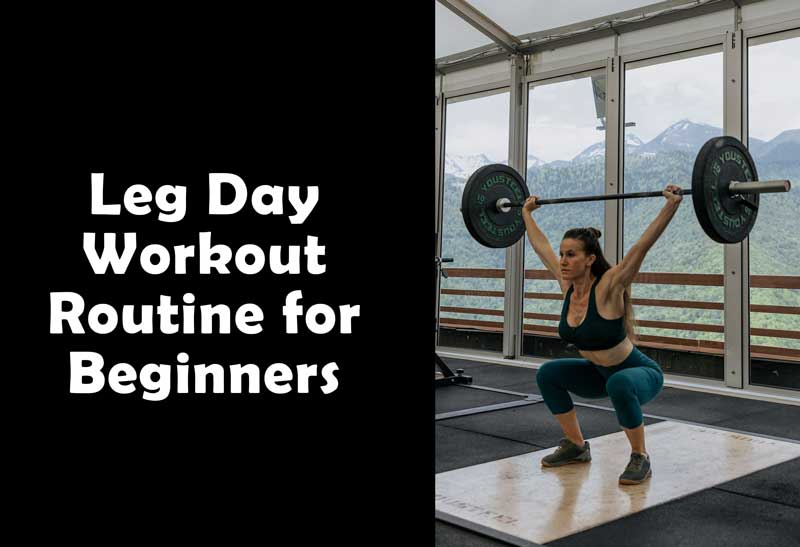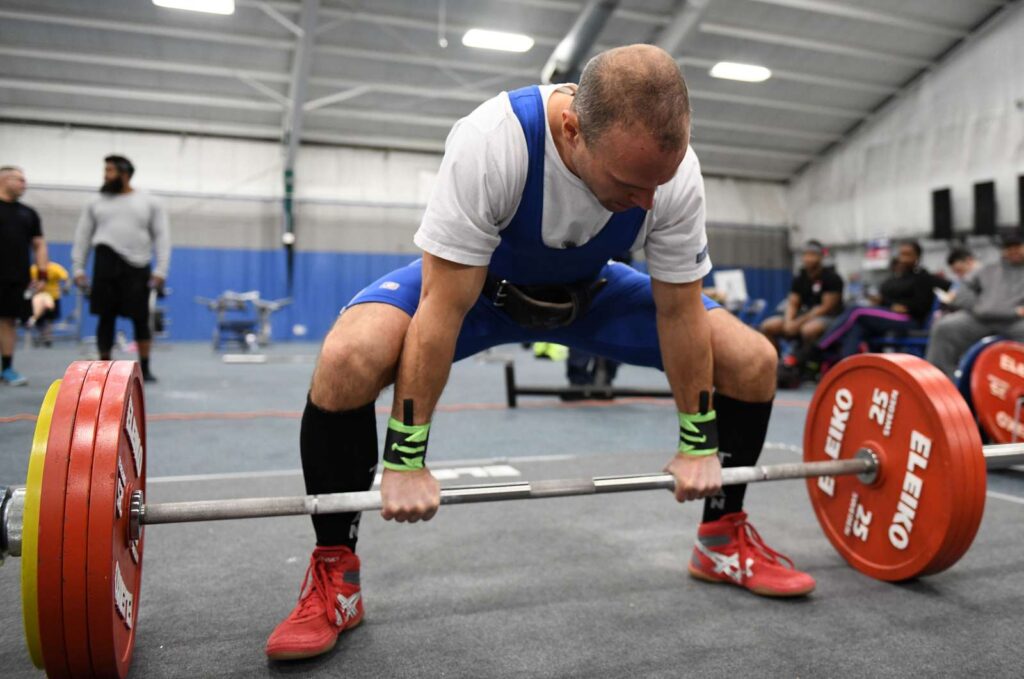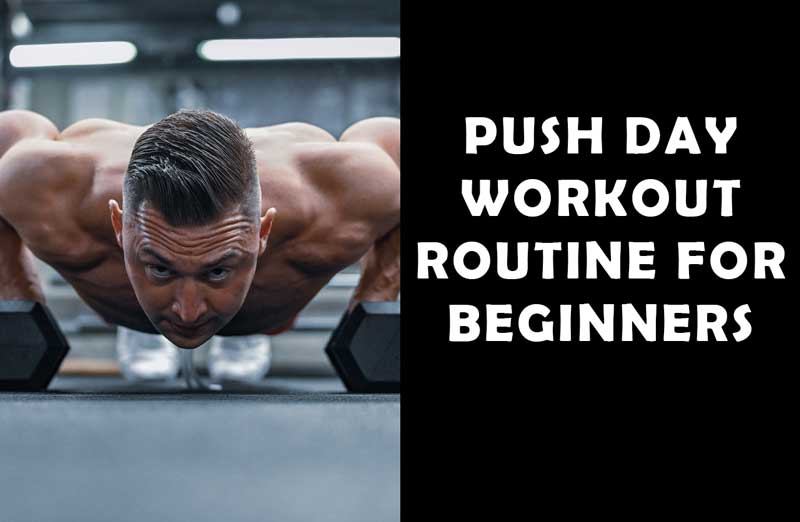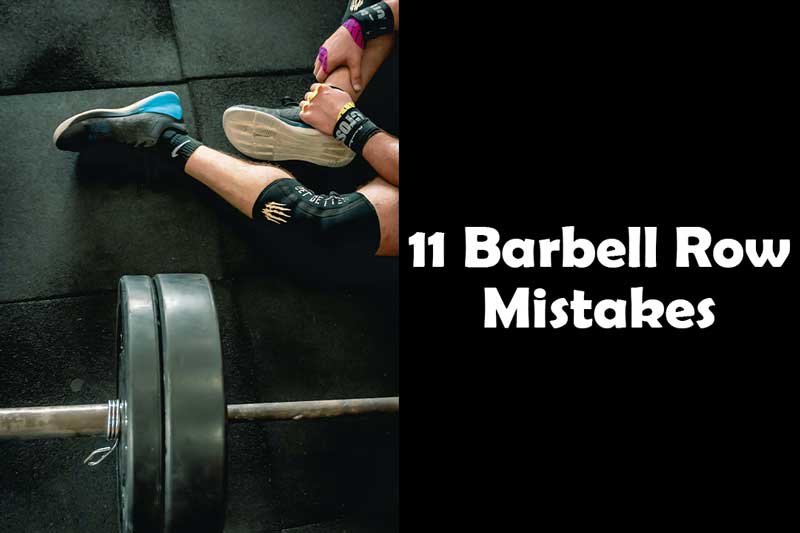Looking to kickstart your fitness journey with a beginners leg day workout routine? Well, you’re in the right place!
Many people neglect leg days and leg workouts, well it’s not everyone’s cup of tea. Even though leg days can be very tiring, tough and not fun, you shouldn’t be like most people and should not neglect leg days.
Leg workouts are an integral part of any fitness regimen, as they not only strengthen and tone your lower body muscles but also contribute to overall balance and stability. In this article, we’ll guide you through a beginner-friendly leg day workout routine that will help you build strength, endurance, and confidence.
Understanding Leg Day Workouts
Before we dive into the exercises, let’s take a moment to understand the significance of leg day workouts.
Leg workouts involve targeting various muscle groups in your lower body, such as quadriceps, hamstrings, glutes, and calves.
These exercises not only promote muscle growth but also enhance functional fitness, making everyday activities easier and more efficient.
Leg workouts can also be included PPL Split (Push-Pull-Leg Split). Where a single day is allocated for leg workouts alone.
Warm-Up Exercises for Leg Day
As with any workout, it’s essential to start with a proper warm-up to prepare your muscles for the upcoming challenges and reduce the risk of injury.
Begin your leg day routine with dynamic movements like leg swings, hip circles, cycling, jumping jacks and high knees.
These exercises increase blood flow to the muscles and improve joint mobility, ensuring a safe and effective workout.
5 Leg Day Exercises for Beginners to Include in Workout Routine
1) Barbell Squats:
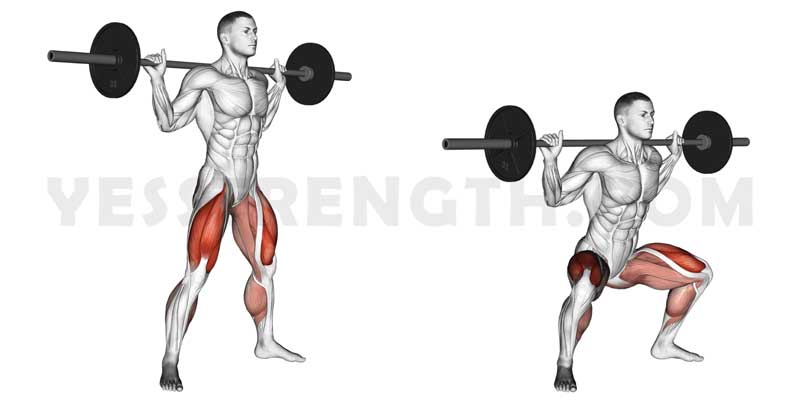
- Start by standing with your feet shoulder-width apart and the barbell resting on your upper back and shoulders. You can also use a smith machine, best for anyone who is starting out.
- Engage your core, keep your chest up, and maintain a neutral spine throughout the exercise.
- Then, slowly lower your hips back and down, as if sitting on an imaginary chair, while keeping your knees aligned with your toes.
- Aim to lower until your thighs are parallel to the ground or slightly below.
- Push through your heels to stand back up to the starting position, fully extending your hips and knees.
- As you are a beginner, start with either an empty barbell or without any weight.
2) Leg Extensions:
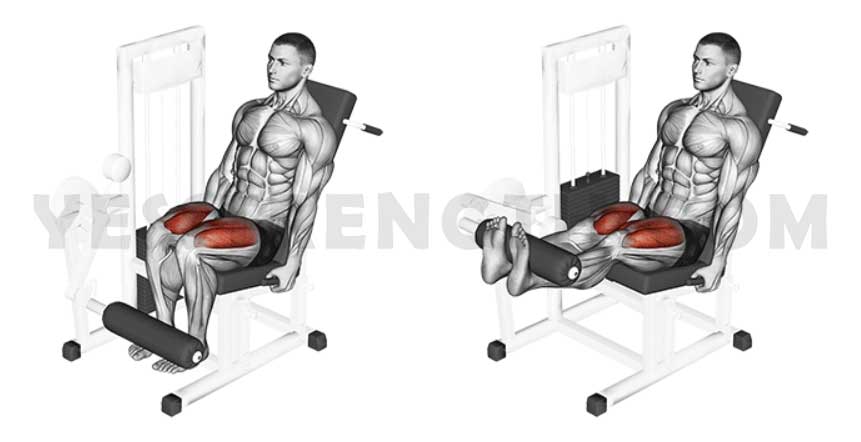
- Begin by sitting on a leg extension machine with your back against the backrest and your legs under the padded lever.
- Adjust the machine so that the padded lever rests just above your ankles.
- Grasp the handles or sides of the machine for stability.
- Extend your legs and straighten your knees, lifting the padded lever upward.
- Pause for a moment at the top, squeezing your quadriceps muscles.
- Slowly lower the padded lever back down to the starting position.
- As you are a beginner, start with light weight and increase gradually.
3) Leg Presses:
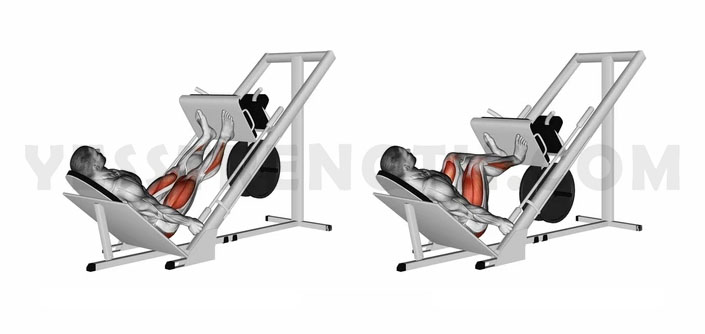
- Sit on the leg press machine with your back against the backrest and your feet shoulder-width apart on the footplate.
- Adjust the seat and footplate position so that your knees are aligned with your toes when your knees are bent at a 90-degree angle.
- Push the footplate away by extending your legs, while keeping your heels firmly planted on the plate.
- Fully extend your legs without locking out your knees, and then slowly lower the footplate back down. Never fully straighten your legs, keep the knees little bent always when the legs are fully extended.
- As you are a beginner, start with light weight and increase gradually.
4) Lunges:
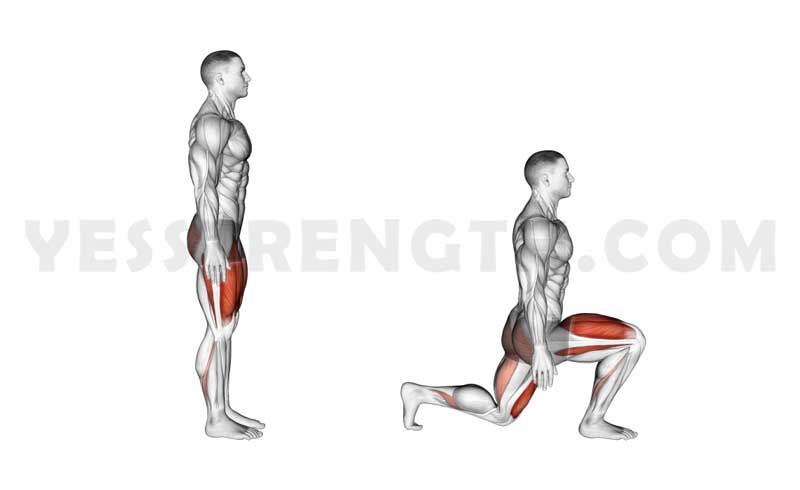
- Start by standing with your feet hip-width apart and your hands on your hips or by your sides.
- Take a step forward with one leg, ensuring a long stride.
- Lower your body by bending both knees until your front thigh is parallel to the ground and your back knee is hovering just above the floor.
- Keep your chest up, core engaged, and maintain a neutral spine throughout the movement.
- Push through your front heel to return to the starting position.
- Repeat with the opposite leg, alternating between legs for each repetition.
5) Calves Raises:
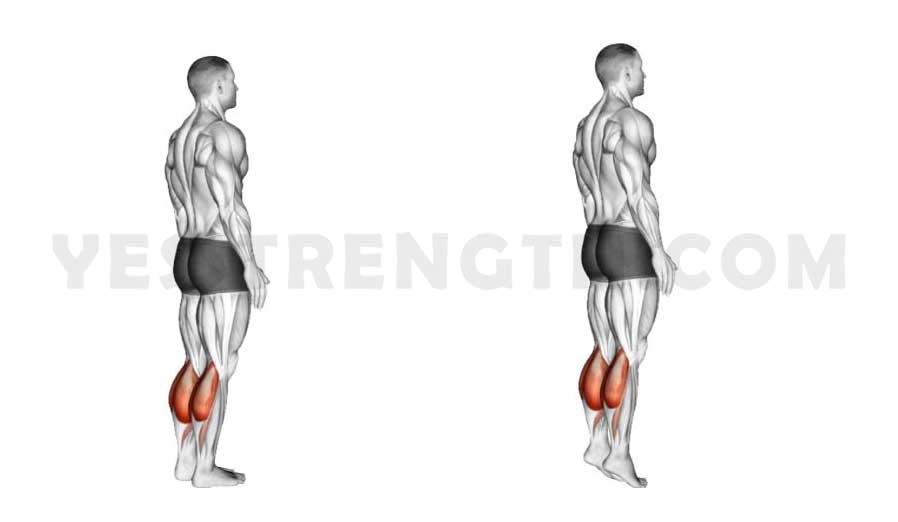
- Begin by standing on the edge of a step, with the balls of your feet on the step and your heels hanging off the edge.
- Hold onto a stable support for balance, such as a railing or wall.
- Slowly raise your heels as high as possible, lifting your body onto the balls of your feet.
- Pause at the top for a moment, feeling the contraction in your calves.
- Lower your heels back down to the starting position, allowing a slight stretch in your calf muscles.
- Repeat for the desired number of repetitions.
Creating a Beginners Leg Day Workout Routine
Now that you’re familiar with several leg exercises, it’s time to create your beginners leg day workout routine.
As a beginner, focus on performing 2-3 sets of 8-12 repetitions for each exercise. Choose a weight or difficulty level that challenges you but still allows you to maintain proper form. Start with bodyweight exercises and gradually incorporate weighted exercises as you gain strength and confidence.
Remember to rest for 1-2 minutes between sets and exercises. Listen to your body and adjust the intensity or volume of the workout as needed.
Below is a sample leg day workout routine suited best for beginners.
Sample Leg Day Workout Routine for Beginners
| Warm Up: | |
| 1) Cycling | 10-15 mins |
| 2) Leg Swings | 10 Reps Each Legs |
| 3) Hip Circles | 10 Clockwise 10 Anticlockwise |
| 4) Jumping Jacks | 30-60 Seconds |
| 5) High Knees | 30-45 Seconds |
| Main Leg Workouts: | |
| Exercises: | Sets x Reps |
| 1) Barbell Squats | 3 x 8 |
| 2) Leg Extensions | 3 x 12 |
| 3) Leg Presses | 3 x 8 |
| 4) Squats | 3 x 20 (10 each leg per set) |
| 5) Calves Raises | 3 x 15 |
You might also Like:
Push Day Workout Routine for Beginners
Pull Day Workout Routine for a Beginner
Benefits of Leg Day Workout Routine for Beginners
Well, the benefits are for everyone, but as a beginner it is recommended to go slow and lightweight as it can cause your legs to really sore the next day.
Here are the best benefits of Leg day-
- Increased lower body strength: Leg day workouts specifically target the muscles in your lower body, such as the quadriceps, hamstrings, glutes, and calves. Regular leg training helps to build strength in these muscles, enabling you to perform daily activities with ease and efficiency.
- Improved balance and stability: Strong leg muscles contribute to better balance and stability, reducing the risk of falls and injuries. Leg day exercises engage the core and help improve overall body stability.
- Increased calorie burn: Leg day workouts are typically intense and involve large muscle groups. As a result, they can help increase your overall calorie burn during the workout and even after. This can be beneficial for weight management and fat loss.
- Boosted metabolism: Building lean muscle mass through leg exercises can help increase your resting metabolic rate. Muscles are metabolically active tissues, meaning they burn more calories at rest. Regular leg workouts can contribute to a higher metabolism and improved body composition.
- Improved aesthetics: Well-toned and sculpted legs can enhance your overall physique and boost your confidence. Leg day workouts help shape and define your lower body muscles, leading to a more aesthetic appearance.
- Full-body hormonal response: Engaging large muscle groups during leg exercises triggers the release of hormones such as testosterone and growth hormone, which play a vital role in muscle growth and overall health. Leg day workouts can have a positive impact on your hormone levels.
Proper Form and Technique
Maintaining proper form and technique is crucial to prevent injuries and maximize the effectiveness of your leg day workouts. Keep the following tips in mind:
- Posture and alignment: Maintain an upright posture throughout the exercises, with your chest up, shoulders back, and core engaged. Ensure that your knees are aligned with your toes during squats and lunges.
- Breathing: Breathe in during the eccentric (lowering) phase of the exercise and exhale during the concentric (raising) phase.
- Controlled movements: Focus on controlled movements throughout the exercises, avoiding any sudden jerking or swinging motions.
Rest and Recovery
Rest and recovery are essential for muscle growth and overall fitness progress. While leg day workouts can be challenging, it’s crucial to give your muscles time to repair and rebuild. Incorporate rest days into your training schedule, allowing your lower body muscles to recover fully.
Additionally, consider stretching exercises after your leg day workouts to improve flexibility and reduce muscle soreness. Stretching helps release tension and promotes blood flow, aiding in the recovery process.
Progression and Tracking
To continuously challenge your muscles and make progress, focus on gradual progression. Increase the weight or difficulty level of your exercises as you become comfortable and stronger. This concept is known as progressive overload and is vital for muscle development.
Track your workouts, noting the weights, sets, and repetitions you perform. This allows you to monitor your progress over time, providing motivation and insights into your fitness journey.
Common Mistakes to Avoid
When starting a leg day workout routine, it’s crucial to be aware of common mistakes and avoid them for optimal results. Some common mistakes to watch out for include:
- Poor form: Always prioritize maintaining proper form and technique to avoid injuries and ensure effective muscle engagement.
- Skipping warm-up: Neglecting a proper warm-up increases the risk of muscle strains and other injuries. Take the time to warm up your muscles before diving into the main workout.
- Neglecting rest days: Rest days are crucial for muscle recovery and growth. Avoid overtraining and incorporate rest days into your training schedule.
- Lack of variety: Keep your leg day workouts interesting and engaging by incorporating different exercises, equipment, or workout formats.
- Setting unrealistic goals: Set achievable goals and celebrate your progress along the way. Unrealistic expectations can lead to frustration and demotivation.
Staying Motivated
Maintaining motivation throughout your fitness journey, including leg day workouts, is essential for long-term success. Here are some tips to help you stay motivated:
- Variety: Add variety to your leg day workouts by trying new exercises, workout formats, or training environments.
- Goal setting: Set realistic short-term and long-term goals, allowing you to measure your progress and celebrate milestones.
- Support system: Surround yourself with like-minded individuals or seek a workout buddy to keep you motivated and accountable.
- Positive mindset: Embrace a positive mindset and focus on the benefits and improvements you experience through leg day workouts.
- Reward yourself: Treat yourself after reaching specific milestones or completing a challenging leg day workout. It could be as simple as a relaxing bath or enjoying a healthy snack.
Conclusion
Incorporating a leg day workout routine into your fitness regimen is a fantastic way to strengthen your lower body, improve overall fitness, and boost your confidence.
Remember to start with bodyweight exercises, gradually progress to weighted exercises, and prioritize proper form and technique. Allow yourself adequate rest and recovery, track your progress, and stay motivated throughout your journey. Get ready to take your fitness to new heights with a well-rounded leg day routine!
FAQs:
1) Can I do leg day workouts if I have knee pain?
If you have knee pain, it’s crucial to consult with a healthcare professional before starting any workout routine. They can provide guidance specific to your condition and recommend exercises that are safe and suitable for you.
2) How often should I do leg day workouts?
As a beginner, aim for two leg day workouts per week, allowing at least 2 or 3 days of rest between sessions. This gives your muscles time to recover and adapt to the exercises.
3) Is it necessary to use weights during leg exercises?
No, it’s not necessary to use weights during leg exercises, especially when starting. Bodyweight exercises alone can be highly effective in building strength and endurance. As you progress, you can gradually incorporate weights to add more challenge and intensity.
4) Can I do cardio on leg day?
Yes, you can include cardio exercises on leg day if your overall fitness goals permit it. However, it’s essential to manage your energy levels and prioritize leg exercises during your workout. Consider alternating cardio days with leg day workouts or performing cardio exercises after your leg workout.
5) How long will it take to see results from leg day workouts?
The time it takes to see results varies from person to person, depending on factors such as genetics, consistency, and intensity of workouts, and overall lifestyle. With regular training and a balanced diet, you can start noticing improvements in strength and muscle tone within a few weeks. Remember, fitness is a journey, and patience is key.

